أخبار
Sustainable and reliable cooling of retail properties
Certified solutions offer security
By Bettina Gehbauer-Schumacher
The challenges for the use of refrigeration and air conditioning systems are manifold. For example, legislation is making the use of natural refrigerants and energy efficiency in building operation more important. This also increases the need to use environmentally friendly systems that work reliably and efficiently on site. For this, it is important that in practice, systems comply with the data specified in the respective manufacturer's information material. Against this background, certifications/certified performance data gives all parties involved the necessary assurances.
The colloquium "Energy-efficient refrigeration systems for supermarkets & shopping centres" offered market participants a platform for exchanging information, experience and opinions on 28 June in Darmstadt. The focus was on solutions certified by "EUROVENT Certifia Certification" (ECC), in order to present the certification system itself for the first time in Germany, through a target-group-specific attendance event. The colloquium was organised by ECC, Paris, and the engineering firm "COOLPLAN" from Munich. The expert exchange took place on the day before the 14th Supermarket Symposium of the German Refrigeration, Air Conditioning and Heat Pump Association (ZVKKW). A follow-up event by Eurovent is planned for autumn 2024 in Germany.
Basics
In the race to adopt green technologies, it is essential to provide planners and system developers with access to reliable data on component/system performance so that systems can be successfully designed and installed, and subsequently used as specified. If this is not the case, the reputation of the technology - and those who specify, design and install it - can be unfairly damaged, if supposedly sustainable systems do not perform as expected in practice and product quality suffers. In addition, operators must ensure - besides trouble-free and energy-efficient operation of refrigeration and air-conditioning systems - that all legal requirements are met and undergo continuous training for this purpose.

When welcoming the 30 or so participants at the Maritim Hotel Darmstadt, Gerhard Frei, owner of Coolplan and consultant to Eurovent, pointed out that the organisers deliberately chose a limited group of participants consisting of manufacturers, system builders and operators as well as planners, in order to ensure a lively exchange. For this, energy-efficient refrigeration components and systems, natural refrigerants as well as certified performance specifications were on the agenda: they are of particular interest for retail properties and flawless food.
Maxiline Tamko, Marketing Manager, ECC, then gave an overview of the six units of the Eurovent Group, of which "Eurovent - European Industry Association" is probably the best known. ECC is in turn responsible for 44 certification programmes, 1,800 tests per year and around 2,600 certifications annually. For commercial applications, the programmes for heat exchangers ("HE - Heat Exchangers"), refrigerated display cabinets ("RDC/RRDC/IRDC Refrigerated Display Cabinet/Remote/Integral"), air handling units ("AHU - Air Handling Units"), chillers and heat pumps ("LCP-HP Chillers & Heat Pumps"), air conditioners ("AC - Air Conditioners") and VRF systems ("VRF Variable Refrigerant Flow Systems") are particularly relevant. More information is available at: https://www.eurovent-certification.com/en/third-party-certification/certification-programmes.
Eurovent relies on a "certify-all" certification system that examines entire manufacturer ranges. Important: You can fall out of the system if both the initial and subsequent measurements of a single unit are not passed in the test laboratory selected for the programme. Heat exchangers (mainly evaporators, condensers, gas coolers), for example, are certified in the TÜV-SÜD test laboratory in Munich/Olching. In addition, a re-measurement by a Eurovent member can be requested at any time.
The thematic introduction to the lecture programme was then given by Roland Handschuh from Refplan Ingenieurbüro für Kältetechnik, Hohenschäftlarn, and Chairman of the Historical Refrigeration and Air Conditioning Association. The Eurovent programmes for certification enable technical traceability because they measure the performance of the units. This prevents underperformance and thus costs for the operators, which is supported by corresponding studies. In addition, the operating costs in the life cycle of a system are six to ten times higher than the investment costs (which have to be paid once). Most operators are not aware of this. Handschuh himself has been working for years with heat exchanger manufacturers on the design of HE programmes, as have leading members of corresponding manufacturers. ECC certifications follow international standards for conformity assessment, such as DIN EN ISO/IEC 17065 "Conformity assessment - Requirements for bodies certifying products, processes and services".
Practical experience
Certification alone is often not enough when the issue in court is that a system does not work, Karl-Heinz Thielmann, an expert from Büro Thielmann and President of the German Refrigeration and Air Conditioning Association (VDKF), illustrated in his presentation on "Performance assessment of heat exchangers from an expert's point of view". What counts here, he said, is measuring on site - if possible and ideally with reference to the dates of commissioning of a system. For him, competition is a main factor. Manufacturers often calculate their prices downwards and buyers too often look exclusively at the cheapest price, especially since purchasing and operation are usually separate cost centres for customers.
In addition to the numerous standards and technical rules, such as DIN EN 327 "Heat exchangers - Fan-ventilated condensers - Test methods for determining performance" and VDMA 24247 "Energy efficiency of refrigeration systems" - Thielmann mentioned the following influencing variables for evaporators and air coolers:
- Material selection, material thickness
- Incoming flow velocity
- Fouling factor (soiling of heat-transferring plant components by substances contained in the cooling water used)
- k-/U-value (heat transfer coefficient; measure for a heat transfer from a fluid (gas or liquid) through a solid body into a second fluid. The drive for this is the temperature difference between the fluids).
- Mass flow.
The formation of ice on the fins of heat exchangers is particularly important to avoid, as it can reduce the output of a system by 20 to 30 percent.
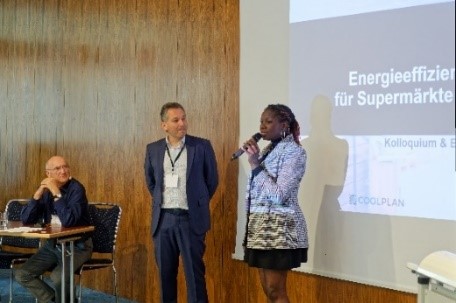
What can a sustainability strategy that works in practice look like across the entire logistics chain? This was demonstrated by Manfred Rössling, Head of Energy Management at Rewe Group Germany. The "Green Building Concepts REWE GROUP - Challenge in Conception and Implementation" initially started with online energy management and the purchase of certified green electricity. Currently, there is a 1,000 roofs programme for the use of photovoltaics (PV) with a maximum output of 99 kWp. Rewe also has a model building specification for its shops that adapts to the respective legal framework. In addition to daylight in the sales area, this means heat pumps with air-conditioning function (refrigerants R410A, R32, R290) and heat recovery from cold, as already demonstrated by the "Green Building" (2009) in Berlin.
The "Green Farming Market" in Wiesbaden Erbenheim from 2021 illustrates the next steps based on this: Apart from the concrete floor slab, the entire building is made of wood (standardised components). The Rewe market supplies consumers in and around the Hessian capital with its own basil and fish farm. The car park has planting and a meadow. The refrigeration technology consists of a compound refrigeration system (CO2 booster), gas coolers with the option of fan reversal and refrigeration units (refrigerated cabinets with glass doors/ceilings). Continuous monitoring, bidirectional communication, control technology and individual parameters help to digitally optimise the operation. Rewe sets itself gradual climate targets. Since 2021, this means reducing its own CO2 emissions by 30 per cent compared to the reference year 2019. The future challenge for this is an efficient and demand-oriented interaction of refrigeration and air conditioning, which would be technically possible, for example, through the use of energy storage instead of more system capacity.
The topic "Current consideration of supermarket concepts" by Andreas Koch, technical expert of Kaufland Stiftung & Co. KG, fitted in well with this. He reported that his company also relies on natural refrigerants - as well as on PV on the roof for stores of 3,000 to 4,000 m2 and glass doors for all refrigeration units. The latter lead to savings per shop equivalent to the CO2 footprint of 4.5 single-family homes. They also increase the comfort in the store. In relation to the Kaufland shops, the sum of measures contributes to realising energy savings of around ten percent. The majority of the energy is used by the refrigeration system, which accounts for about 50 per cent of the energy demand; of this, about 80 per cent is used by the compressor. Kaufland relies on the interaction of refrigeration and air conditioning: either in combination or in combination with an external heat pump using the refrigerant propane (R290). In addition, there is energy monitoring according to ISO 50001, which is monitored by DEKRA, and a manufacturer-independent platform for optimising operations. The branch in Eppingen already received the environmental award of the state of Baden-Württemberg in 2010.
Current products
A great deal happens in the development of technical building equipment. However, in order to be able to comply with the calculated planned values during operation, it must be known what the user wants, and how this can be achieved with the lowest possible energy consumption. In supermarkets, the compressors draw the largest share of energy, which Michael Nagler, Sales Manager of Bock GmbH, addressed in his presentation on "Efficient and performance-certified compressors". Bock is now part of Danfoss. This also means that the products have "ASERCOM" certification. Bock is a founding member of the certification organisation specialising in compressors. In order to harmonise safety regulations and technical standards, the company also works together with the Institut für Luft- und Kältetechnik gemeinnützige Gesellschaft mbH (ILK Dresden), the Fachverband Gebäude-Klima e.V. (FGK) and TÜV SÜD.
Like ECC certification, Asercom focuses on the control and plausibility check of products available on the market and their manufacturer information - in the future especially on CO2 compressors. Nagler sees the most potential in the design of compressors (thermal separation) and the use of LSPM motors. Such a line-start permanent magnet motor alone can increase the efficiency of a compressor by an average of five to six percent. In combination with the digital power controller "flexxCO2 NTROL", further optimisation possibilities can be realised. Very topical: On 29 June, the "Danfoss Smart Store ADC" opened in Nordborg, Denmark. The application development centre is located at Danfoss headquarters and serves as a live demonstrator for testing new solutions. It contains Danfoss products, components and (networked) applications that individually and, more importantly, in combination, drive decarbonisation of a plant.
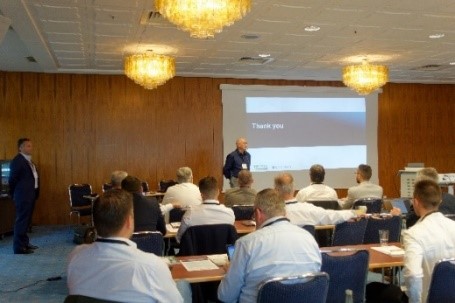
Heat exchangers also come into play here. They are relevant for many different areas of application. A major topic here is the switch to natural refrigerants planned by EU legislation (F-Gas Regulation, REACH Regulation). Refrigerants made from Hydrofluorocarbons (HFCs) are to be phased out because of their high global warming potential (GWP). One alternative is the non-toxic and non-flammable refrigerant R744 (CO2 ).
A brief digression on this: Due to the increased use of R744 systems and market requirements, ECC introduced a special performance evaluation procedure for CO2 heat exchangers. A modern test stand was developed at TÜV SÜD's "Competence Centre for Refrigeration and Air Conditioning Technology" for the performance certification. The programme, based on a voluntary approach, certifies the product's performance impartially - through audits, software validation and product testing in an independent laboratory, with specific performance elements for both
- CO2 evaporator (four standard conditions for output [kW], power consumption [W], energy parameter R, energy class, air volume flow [m3 /h]) as well as for
- CO2 gas cooler (Standard power [kW], power consumption [W], energy rating R, energy class, Air flow rate [m3 /h], A-weighted sound pressure level [dB(A)], A-weighted sound power level [dB(A)]).
For the testing of CO2 systems according to DIN EN 327 and DIN EN 328, an innovative test stand was developed in the "Refrigeration and Air Conditioning Competence Centre" of TÜV SÜD Industrie Service GmbH. It includes precise performance measurements both under standard conditions and outside the normally required conditions.
With the new test stand it is possible to measure CO2 evaporators with capacities up to 40 kW and gas coolers up to 100 kW. By using four compressors with different capacity levels, systems of different sizes and capacities can be tested. Due to the high pressure resistance of the refrigerant-carrying components used, measurements in the trans-critical and sub-critical range are possible.
Built-in components include pipes, safety valves, connectors and flexible hoses to meet the requirements of a wide range of applications and test facilities. In addition, the test stand can withstand thermal loads in a temperature range of up to - 40°C in evaporative mode and up to 120°C in gas cooling mode.
Since carbon dioxide is odourless and displaces oxygen, the test chambers in the TÜV SÜD laboratory are equipped with appropriate sensors and warning systems to ensure safe operation.
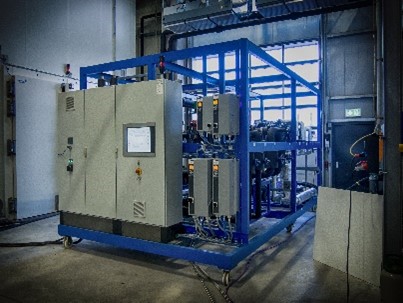
The Eurovent certificate ensures honest competition, said Ceslovas Kizlauskas and Osama Aljolani, technical experts from the development department of Kelvion Germany GmbH. In their presentation "Heat exchangers for refrigeration and heat pump technology", they too saw the use of CO2 as a refrigerant as promising: It has a high specific capacity, a low pressure drop and a GWP of one. The CO2 and HFC air coolers (evaporators) are ECC-certified, as are Kelvion's drycoolers, condensers and gas coolers. ECC is planning a HE programme extension for brine and ammonia (NH3 ) air coolers (evaporators). Kelvion offers customised heat pump outdoor evaporators (10 to 250 kW) as well as standalone evaporators or integrated in a gas cooler as flat-bed and V-bank versions (50 to 400 kW). With the "Select PHE Software", customers can, for example, pre-configure their intended air coolers - the software then shows which specific units are suitable as a solution in each case. Already realised examples are the Edeka market in Berlin-Spandau, the wholesale market Aligro and the supermarket Migros (both in Switzerland).
Swegon Germany GmbH is a pioneer in the use of the natural refrigerant propane, as André Schulz explained in his presentation "Efficient and intelligently controlled propane heat pumps in the retail sector" . In Germany, his company stands for several brands (Zent-Frenger, SLT, Blumartin, Barcol-Air, Fujitsu) and has the mission of causing no emissions for itself and its customers. Service is the central offer for this. He presented the "TITAN SKY" series from Swegon as a future-proof cooling solution for supermarkets. Characteristic features of these outdoor units:
- Control cabinet is isolated from the compressor area.
- Reciprocating compressor is optimised for R290 and follows EU "ATEX" directives.
- Special HVAC inverter (30 to 65 heart frequency range).
- "ATEX" - Leakage warning device.
- Copper tubes with reinforced wall thickness.
- Reduced refrigerant charge.
In combination with a brine-to-water heat pump, a heat pump for markets with meat processing and heat recovery as indoor units, the titanium outdoor units enable environmentally friendly and demand-oriented operation. Propane has a GWP of three and comes with a five per cent bonus as part of a BAFA subsidy. Swegon attaches great importance to the tightness of its systems.
The subsequent discussion confirmed the relevance of this point: the direct greenhouse gas effect of refrigerants only becomes effective when the refrigerant escapes into the atmosphere, which does not happen or only to a small extent during proper operation. This means that an environmental impact is caused purely by the leakages, not by the respective total charge. The VDKF has more than 200,000 systems under monitoring via its "LEC software" and gives the average leakage rate of all of them as 1.3 per cent. In contrast, actors at the political level often assume a leakage rate of 25 per cent in their considerations.
Certification
LU-VE's motto "naturally transparent" is one of the company's interfaces with ECC and refrigerants. LU-VE manufactures laminated heat exchangers in a wide range of product series. They all have certification - just as around 67 percent of all HVAC products sold in Europe have ECC certification. 27 independent test laboratories and agencies carry out performance certifications on behalf of ECC.
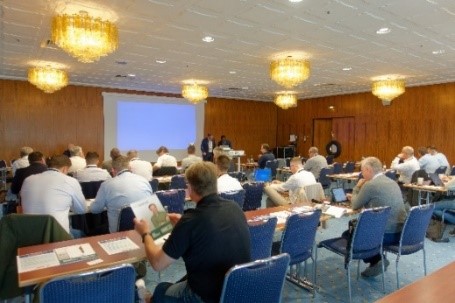
In his presentation, Gerhard Neuhauser from LU-VE Deutschland GmbH, backed up his statement "Non-certified products = higher energy consumption and damage to our environment" with two case studies. The one for air coolers shows that non-certified products have 17 times (deep-freezing) and 12 times (normal cooling) higher energy consumption per year compared to certified equipment. These costs would be about 4.2 times the investment price.
The results of the second study on CO2 gas coolers are as follows:
Case study 1: Certified product
Economic simulation considering energy costs of 0.25 €/kWh
| Power consumption of the system | 1,456 MWh/a |
| Electricity costs of the gas cooler fans | 8.134 €/a |
| Electricity costs for the compressor | 355.746 €/a |
| Total costs | 363.880 €/a |
Case study 2: Non-certified product with 25% oversizing coefficient
Economic simulation taking into account energy costs of 0.25 €/kWh
| Power consumption of the system | 1,518 MWh/a |
| Electricity costs of the gas cooler fans | 8.633 €/a |
| Electricity costs for the compressor | 370.824 €/a |
| Total costs | 379.457 €/a |
Summary of consumption and cost increase due to the use of non-certified CO2 gas coolers - difference between case 1 and case 2
| Power consumption of the system | + 4,2 % | 62 MWh/a |
| Electricity costs of the gas cooler fans | + 6,1 % | 499 €/a |
| Electricity costs for the compressor | + 4,2 % | 15.078 €/a |
| Total costs | + 4,3 % | 15.577 €/a |
Even if the difference between the two simulations may seem small at first glance, the effects on annual consumption and thus costs are not negligible. The greater the discrepancy between the stated capacity and the actual capacity, the greater the impact on the energy consumption of the installation.
Gerhard Neuhauser's conclusion is accordingly: Certification can both identify and prevent products with faulty performance. It is an insurance for suppliers, plant manufacturers, end customers and planners. The question remains: How does ECC certification actually work? This was presented by Gerhard Frei from the engineering firm Coolplan. There are 3 decisive steps here, see Figure 6:
- Request for product certification (selection of audits, products and testing laboratory)
- Data analysis & validation (test, audit, evaluation, report, decision, certificate, online data provision)
- Annual decision on the Eurovent certificate award and the scope of certification. Publication of the certified company, products and data at: www.eurovent-certification.com)
In his contribution "Advantages of the certification of refrigeration components for system efficiency", Frei also mentioned measures that are decisive in the design of systems (load calculation, concept, component match, full and partial load), and especially in the design of finned air-loaded heat exchangers. Here, for example, the heat transfer characterised by the pipe connection, flow form, pressure losses, internal heat transfer, as well as external heat transfer from the pipe to the fin, plays a decisive role. Using examples with varied fluid/air volume flows, the influences of pressure loss (dp), Reynolds number (Re) and heat transfer coefficient (U-value) on the full and part load performance of air coolers were demonstrated in order to better understand the impact of misdeclared performance data and physical limits of heat transfer in part load operation.
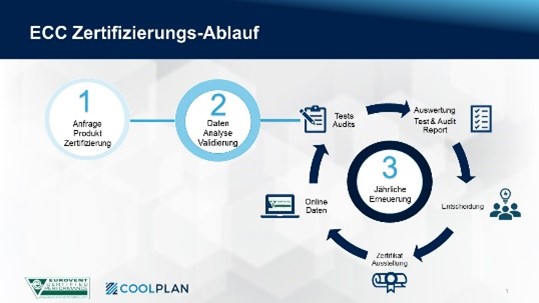
For efficient operation, it is above all important to have an overall understanding of the technical interrelationships, and the refrigeration application, in order to be able to operate the respective systems optimally at full and partial load: Planners, operators and users must understand the interfaces in order to be able to correctly assess the effects of their actions. Software solutions are a proven aid for this, if they are tailored to the respective requirements, and the users do not blindly rely on them, but have an eye on the plausibility of the data in each case.
The performance data of a facility and its components affect system efficiency at all levels. Therefore, reliable data, such as that provided by certification, is a central step for energy, cost and emission reductions and ultimately for a healthy living environment. Frei sees optimisation potential primarily in heat exchangers and the interaction of components and operating points. This is followed by the topics of control concepts and compressor technologies.
Outlook
As an introduction to the concluding discussion, Gerhard Frei asked the audience what they would like to see from manufacturers and EU institutions. ECC currently certifies HFC refrigerants for evaporators and condensers, as well as R744 for evaporators and gas coolers. The reference value/reference for evaporators and condensers with HFC is R404A; for CO2 evaporators and CO2 gas coolers R744.
For the future of refrigeration systems, the participants of the colloquium saw potential in the refrigerant propane (R290) with indirect systems and refrigerant carriers (glycol, ice slurry) or direct evaporating NH3 systems. Their significance for practice will be shown by the concrete technical and legal developments. The manufacturers themselves are examining many options on the subject of refrigerant. For certification, it is crucial that the system-relevant data can be measured/verified and compared.
The increase in indirect systems is increasingly leading to the use of plate heat exchangers - both as evaporators and condensers. Certified performance of plate heat exchangers and air coolers with refrigerants is thus gaining in importance. Corresponding certification programmes must be set up for this.
Heat recovery, heat and cold storage are also increasingly used. The latter can buffer peak cooling load requirements and significantly reduce the dimensioning of refrigeration systems while ensuring efficient part-load operation.
The goal is to promote energy efficiency and sustainability. Digitalisation can also help with this. However, it is crucial that all those involved gain an overall understanding of what has to happen when and why, so that efficient and sustainable operation really succeeds with building automation.

Where is the market heading? Rewe's answer to this is operator safety (performance, control behaviour, tightness, quality) through coordinated components/concepts. Due to the increased use of indirect R290 units with refrigerants, reliable performance data of air coolers and plate heat exchangers is required.
Another point of discussion was a possible certification of the manufacturer's software (compressors and heat exchangers), so that planners can design and use a system correctly.
To this end, there will be a Eurovent meeting on heat exchangers in July 2023 to discuss, among other things, the future reference refrigerants for certifications.
The whole thing is difficult to test - the relevant standard only specifies how calculations have to be made and the focus is currently on the output of certified data within the software.
Looking closely at/certifying certain partial load points could be a starting point to be able to check the back-calculation of data to design data in manufacturer software.
In contrast, compressors are easier to check during operation at operating points. The verification of performance data in indirect systems with refrigerants can also be implemented without great effort by installing heat meters.
In the case of finned air-blown heat exchangers, several general conditions play a role, for example possible fouling, the manufacturing quality and the heat transfer from fin to tube over the operating period of x years. Underperformance or performance losses of heat exchangers are not so easy to identify in dynamic plant operation, which makes reliable performance data and quality monitoring through audits all the more important.
In order to obtain reliable reference values for operation, the panel recommended measuring a plant during commissioning and documenting the values determined. During operation, these should then be compared with the current data. AI can be used for this, both to enable predictive operation and to identify weak points. This and the use of certified products and components can ensure that the manufacturer's specifications are adhered to when designing and operating a system.
Because for the goal of environmentally friendly action, it is the practice on site that counts - not the calculated value of a system. This means that, at best, only the necessary measures should be taken precisely and everything else should be omitted. In addition, comprehensive transparency about the condition of the building and the facilities is indispensable. These and other aspects were explored in greater depth during a joint dinner - including a tour of the Darmstadt private brewery and beer tasting - which rounded off the day of the event for mutual exchange between manufacturers, operators and planners.


